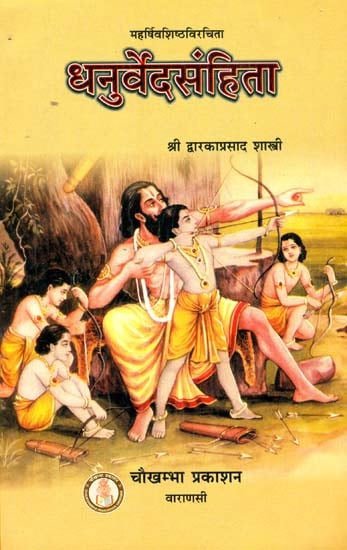Dhanurveda Samhita [sanskrit]
3,015 words
The Sanskrit text of the Dhanurveda-samhita attributed to Vasishtha. Dhanur Veda is a type of ancient India science whose roots date to the 2nd millenium BCE. It is counted among the Upavedas literature. This specific version of the Dhanurveda contains roughly 240 sections of Sanskrit text.
Verse 2.1
इत्यस्त्रप्रकरणम् ।
।
अथौषधिः ।
हस्तार्के लाङ्गली कन्दो गृहीतस्तस्य लेपतः ।
शूरस्यापि रणे पुंसो दर्पं हरति कातरः ॥ १ ॥
ityastraprakaraṇam |
|
athauṣadhiḥ |
hastārke lāṅgalī kando gṛhītastasya lepataḥ |
śūrasyāpi raṇe puṃso darpaṃ harati kātaraḥ || 1 ||
Note! The following is not a translation of the above verse, but merely an arbitrary extract of the English text.
This is the weapon case. . Athaushadhih. He took a long tuber in his hand and smeared it on him Fear takes away the pride of even a hero in battle.
English translation by Hardayalu Swami (2001) Buy now!
Glossary of Sanskrit terms
Note: This extracts Sanskrit terms and links to English definitions from the glossary, based on an experimental segmentation of verse (2.1). Some terms could be superfluous while some might not be mentioned. Click on the word to show English definitions.
Itya, Tri, Tra, Aprakarana, Atha, Aushadhi, Hasta, Arka, Langali, Langalin, Kanda, Grihitri, Grihita, Tad, Lepat, Shura, Api, Rana, Pums, Darpa, Harat, Katara,
Analysis of Sanskrit grammar
Note: this is an experimental feature and only shows the first possible analysis of the Sanskrit text (Verse 2.1). If the system was successful in segmenting the sentence, you will see of which words it is made up of, generally consisting of Nouns, Pronouns, Verbs, Participles and Indeclinables. Click on the link to show all possible derivations of the word.
- Line 1: “ityastraprakaraṇam |”
- ityas -
-
itya (noun, masculine)[nominative single]√i -> itya (participle, masculine)[nominative single from √i class 2 verb]
- tra -
-
tṛ (noun, neuter)[compound], [adverb], [nominative single], [vocative single], [accusative single]tra (noun, masculine)[compound], [vocative single]tra (noun, neuter)[compound], [vocative single]
- aprakaraṇam -
-
aprakaraṇa (noun, neuter)[adverb], [nominative single], [accusative single]
- Line 2: “athauṣadhiḥ ”
- athau -
-
athā (indeclinable)[indeclinable]atha (indeclinable)[indeclinable]
- auṣadhiḥ -
-
auṣadhi (noun, feminine)[nominative single]
- Line 3: “hastārke lāṅgalī kando gṛhītastasya lepataḥ ”
- hastā -
-
hasta (noun, masculine)[compound], [vocative single]hasta (noun, neuter)[compound], [vocative single]hastā (noun, feminine)[nominative single]
- arke -
-
arka (noun, masculine)[locative single]arka (noun, neuter)[nominative dual], [vocative dual], [accusative dual], [locative single]
- lāṅgalī -
-
lāṅgalī (noun, feminine)[compound], [nominative single]lāṅgali (noun, masculine)[nominative dual], [vocative dual], [accusative dual]lāṅgalin (noun, masculine)[nominative single]
- kando* -
-
kanda (noun, masculine)[nominative single]
- gṛhītas -
-
gṛhītṛ (noun, masculine)[vocative single]gṛhīta (noun, masculine)[nominative single]√grah -> gṛhīta (participle, masculine)[nominative single from √grah class 9 verb]
- tasya -
-
√tas -> tasya (absolutive)[absolutive from √tas]ta (noun, masculine)[genitive single]ta (noun, neuter)[genitive single]tad (noun, neuter)[genitive single]sa (noun, masculine)[genitive single]√tas (verb class 4)[imperative active second single]
- lepataḥ -
-
√lep -> lepat (participle, masculine)[accusative plural from √lep class 1 verb], [ablative single from √lep class 1 verb], [genitive single from √lep class 1 verb]√lep -> lepat (participle, neuter)[ablative single from √lep class 1 verb], [genitive single from √lep class 1 verb]√lip -> lepat (participle, masculine)[accusative plural from √lip class 1 verb], [ablative single from √lip class 1 verb], [genitive single from √lip class 1 verb]√lip -> lepat (participle, neuter)[ablative single from √lip class 1 verb], [genitive single from √lip class 1 verb]√lep (verb class 1)[present active third dual]√lip (verb class 1)[present active third dual]
- Line 4: “śūrasyāpi raṇe puṃso darpaṃ harati kātaraḥ ”
- śūrasyā -
-
śūra (noun, masculine)[genitive single]śūra (noun, neuter)[genitive single]
- api -
-
api (indeclinable preposition)[indeclinable preposition]ap (noun, neuter)[locative single]api (Preverb)[Preverb]
- raṇe -
-
raṇa (noun, masculine)[locative single]raṇa (noun, neuter)[nominative dual], [vocative dual], [accusative dual], [locative single]
- puṃso* -
-
puṃs (noun, masculine)[accusative plural], [ablative single], [genitive single]
- darpam -
-
darpa (noun, masculine)[adverb], [accusative single]
- harati -
-
√hṛ -> harat (participle, masculine)[locative single from √hṛ class 1 verb]√hṛ -> harat (participle, neuter)[locative single from √hṛ class 1 verb]√hṛ (verb class 1)[present active third single]
- kātaraḥ -
-
kātara (noun, masculine)[nominative single]
Other editions:
Also see the following editions of the Sanskrit text or (alternative) English translations of the Verse 2.1
Dhanurveda Samhita (धनुर्वेदसंहिता)
by Hardayalu Swami (2001)
Publisher: Khemraj Shrikrishnadass
Buy now!
Vasistha’s Dhanurveda Samhita
by Purnima Ray (2023)
Publisher: Khemraj Shrikrishnadas; ISBN-10: 818670289X; ISBN-13: 9788186702895; 88 pages including 18 illustrations;
Buy now!
Dhanurveda Samhita (धनुर्वेदसंहिता) (संस्कृत एवं हिंदी अनुवाद)
by Shri Dwarka Prasad Shastri (2007)
Title: Dhanurveda Sanhita (Hindi translation); Publisher: Chaukhambha Prakashan, Varanasi; 84 pages including 11 illustrations; Author: महर्षि वशिष्ठ (Maharshi Vashistha); Foreword by Dr. Chakradhar Bijalwan.
Buy now!![Dhanurveda Samhita [sanskrit] - book cover](/uploads/a/Dhanurveda-Sanskrit.jpg)

